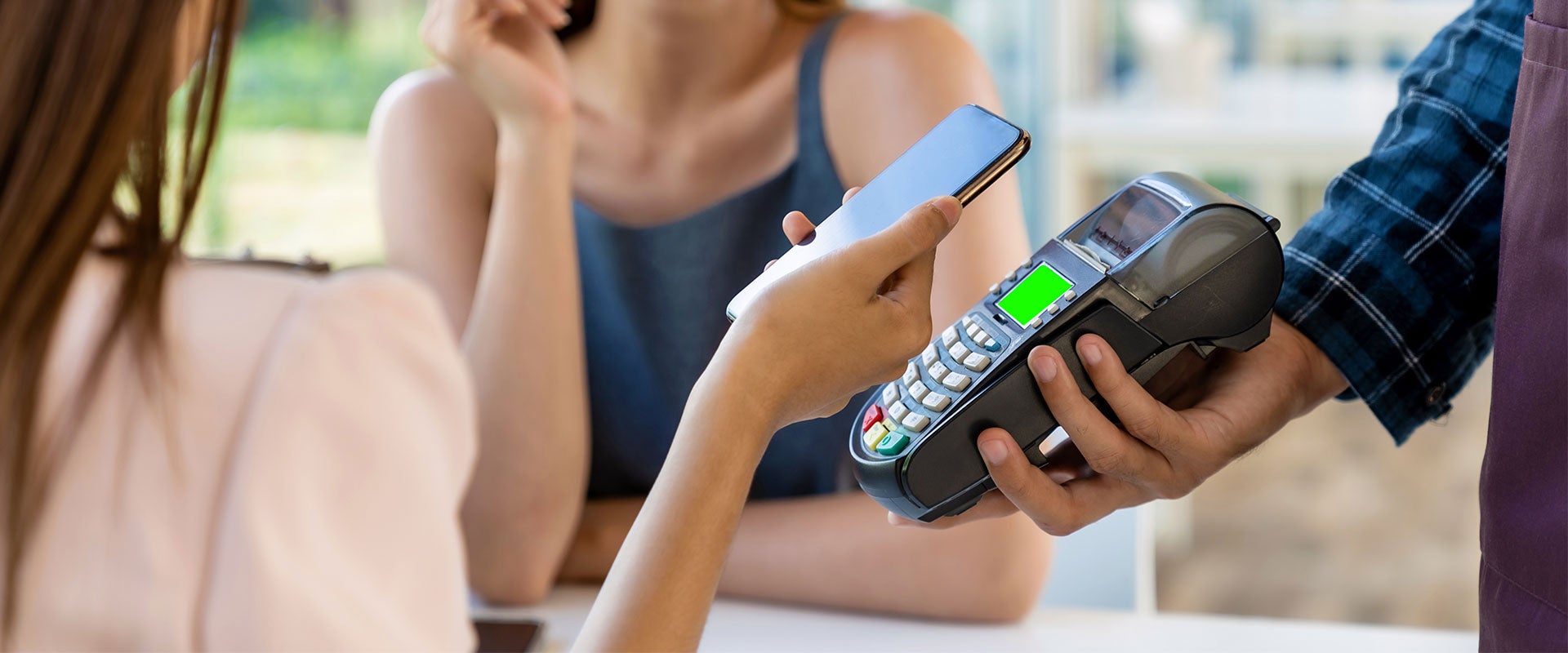The data sources that operators can leverage
Operators can take advantage of a number of data sources to better understand and serve the consumer, driving sales and loyalty in the process: brand apps, third-party apps, geotagging, social media, traditional email, and the data gleaned from consumer footfall and credit cards.
Brand apps – Brand apps with ordering capabilities drive huge benefits for both the consumer and the brand if done the right way. The apps track real-time transaction data and provide a direct connection with the consumer in the same way that direct-to-consumer businesses do in other consumer subsegments.
This attributable order data enables operators to personalize the experience for the consumer based on order history (e.g., with phrases such as “You might also like” and “We recommend for you”), offer bespoke promotions (e.g., a discount on a consumer’s favorite meal after they stop purchasing in order to reengage them versus offering blanket discounts when they would have purchased anyway), and drive up average order value (e.g., by including an “add a drink” option at checkout). It can also build community through content and serve as a platform for a loyalty program and/or gamification (e.g., Starbucks Star Points).
Finally, preordering on an app for delivery or collection can have a significant impact on the customer experience, driving improved retention/repeat rates while reducing operating costs.
- McDonald’s introduction of its app has elevated its customer targeting and engagement while enabling it to more accurately measure the effectiveness of its marketing and forecast future performance.
- Fast casual chain Sweetgreen’s app allows customers to preorder their salad/bowl for pickup at a specified time so they can skip the lunch lines, which enables the chain to better manage its meal prep timelines, reduce wait times and open smaller footprint “pickup only” sites/outposts.
Third-party apps – For most operators, some portion of their digital sales is also coming from third-party apps (e.g., Uber Eats, Grubhub, DoorDash). At the same time, those apps are becoming an important source of data.
- The ad platform for Uber Eats allows brands to target their ads based on consumer location, order history and food preferences.
- Grubhub/Seamless offers similar capabilities to reach, engage and retain customers. Its promotions dashboard lets operators set goals for attracting new customers and reengage with past customers.
Geotagging – Operators can engage customers in a customized way by geotagging their locations and then sending messages to those customers when they are nearby. In a recent study by Epsilon, 41% of consumers indicated they had tried a new restaurant because it was near to them.
Other tactics include geofencing, which uses GPS to define boundaries around a physical space to enable geolocation-based ads, and geoconquesting, where operators target customers visiting competing restaurants and push deals to them in an attempt to redirect their business.
Many restaurant and foodservice chains have partnered with providers of data analytics to receive customer location data and push targeted ads and promotions to customers when they’re nearby. Starbucks, for example, is a long-standing user of location-based advertising, leveraging in-store Wi-Fi and other network partnerships abroad to identify nearby phones and then send coupons for discounted products to the associated customer.
Social media – Many QSR brands are successfully engaging in social media. While some are leaning in to respond to Yelp reviews (e.g., Chop Shop in Colorado is proactively responding to consumer comments, good or bad), the wider community-building initiatives they’re taking are creating loyalty/repeat purchasing while also bubbling up new product innovations. Wingstop is a good example of a chain focused on reposting user-generated content to great success.
TikTok is proving to be an especially powerful social media platform for restaurants. According to a 2021 survey, 36% of TikTok users and 65% of TikTok content creators visited or ordered food from a restaurant after seeing a video about it on the platform, enticed by its appetizing food (55%) or unique menu items (51%).
Sweetgreen is a prime example of engaging with consumers on TikTok. Recipe content is popular on social media, so Sweetgreen posts instructional videos such as how to chop ingredients, how to make the popular dressings offered by the chain — even full salad tutorials. Dunkin’, meanwhile, collaborates on TikTok with influencers like Charli D’Amelio to help drive increased digital traffic and purchases in its stores.
Traditional email – Email sign-ups — and subsequent email campaigns — are another great way to keep consumers engaged. Steak ’n Shake, for example, funnels Instagram and website users to its loyalty reward email sign-up for an initial incentive of a free ice cream shake, followed by a loyalty incentive whereby customers earn a $5 reward for every $50 spent.
The more first-party data a restaurant has about consumers, the better. Email addresses — or even better, phone numbers — are great identifiers, and can be combined with third-party data to give a more holistic view of a consumer. When combined with transaction data from restaurant orders (e.g., through the app), the restaurant can start segmenting its customer base into personas. It can subsequently target the right consumers with the right offers or prompts, at the right time, to encourage repeat orders. For example, a customer who visits every Tuesday but stops will trigger a reminder email.
Other data sources – Other sources of data can be used more tactically, most notably footfall and credit card data.
-
Footfall data: Detailed footfall location data, which maps the flow of guest traffic, can be used to understand how many people are in a store at certain times of the day as well as where else they have shopped and how many of those locations feature competitors. Operators can leverage such data to adjust its in-store layout to optimize guest flow, implement solutions to minimize wait times during busy periods, understand customer characteristics (e.g., where else they shop nearby), select new sites, target its marketing to increase ROI and understand where else customers are going, including any nearby competitors.
-
Credit card data: Data from credit cards offers another lens into cross-shopping, namely the other brands a restaurant’s customers are eating at and which among them is gaining momentum. Such data can also reveal, for example, that the majority of a restaurant’s customers go to gym X or shop at grocery store Y, which allows them to do more targeted out-of-home and digital marketing, in turn increasing their marketing ROI.
Credit card data can also be linked to customer loyalty. For example, using Toast, restaurants can integrate loyalty programs into the guest checkout experience. Guests can opt in during checkout and will accrue points each time they pay using the same card. This not only generates loyalty but also gives the restaurant more insight into repeat-visit rates.
All this data is in addition to the traditional data generated by point-of-sale (POS) and reservation systems, which allows a restaurant to optimize its menu offerings, its approach to food procurement and waste, and its marketing (e.g., more salad is sold than rice bowls, so market the salad more) as well as its table turnover rates and staffing patterns. Given the rising food costs, higher labor costs and frequency of labor shortages that restaurants are currently experiencing, these valuable data assets should not be overlooked.
How to take advantage of the data opportunity
In our ever-more digital world, investing in data collection and analysis to leverage the vast amount of consumer information available is critical to a restaurant operator’s success. And it’s not too late to get started. Even some of the largest chains are still at the beginning of their data journey. But big or small, all operators need to take the same basic steps:
Gather a wide range of data – Invest in consumer-facing data sources to ensure you are capturing enough touchpoints to create a holistic picture of your guest.
Leverage data science capabilities and technology – In order to visualize the insights coming from these disparate big data sets, invest in data analytics capabilities and fit-for-purpose tools/software:
- Clean and organize the data so it is useful and useable
- Seeing the data organized on a screen (e.g., in a visualization/dashboard tool) will enable you to spot patterns and make decisions more easily
- Follow the lead of other industries like direct-to-consumer (DTC) businesses with their use of software tools like customer data platforms (CDPs) to manage customer data
Derive insights and put them to work – To maximize the value of your data, which includes reacting to any changes in behavior, you should build out analytics models that can help you drive value for the consumer and improve internal operations, for example:
- Segment your customers so that you can tailor things like overall promotions, new menu items, and marketing campaigns to that group and their look-alikes
- Leverage predictive analytics, which identifies typical trigger behaviors that you can react to and use to influence outcomes (e.g., certain behavioral triggers that indicate potential churn can be countered by targeted promotions)
Personalize and tweak offerings further to increase ROI – To up your return on investment, personalize the offers you make to consumers as well as how you make them:
- Constantly assess the ROI of offers through test and trial; personalized offers can be more effective especially if they are driving up customer lifetime value through more frequent visits (e.g., time-limited coupons, prompting them about their favorite order) or larger average order values (add a side for only $x, two for $x, “you may also like” recommendations).
- Understand individual behavior to optimize ROI for each consumer. Is a particular consumer more likely to buy on discount? Then offer them a promotion. Do they always order, say, chips and a drink? Then prompt those offerings, every time.
There are numerous insights that consumer data will surface, from the effectiveness of particular marketing campaigns to the impact of customized offers to the need to innovate your products. While the amount of data, and the seemingly endless ways to leverage it, can feel overwhelming at first, at the end of the day the goal is to create loyal — in other words, repeat — customers. To that end, data should be used to determine what is important to them and what their preferences are.
While there is an abundance of consumer data available to restaurant chains, choosing the right data, having the capabilities to crunch it and then putting it to work is what will drive value for operators going forward. Aligning on goals will be critical to determining how to prioritize data usage and what insights to get out of it. The first step, however, is to acquire, through building or partnering or both, the means to gather consumer data from multiple sources. Then, crucially, operators will need help developing the capabilities necessary to manage, interpret and leverage it.






